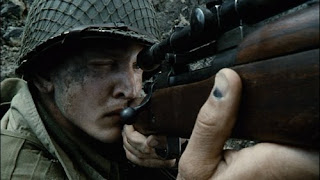
At times, in his directorial debut Lost Souls for instance, he can use heavy shadows and limited background to give a feeling of isolation as the main character feels more and more alone as he realizes there is little he can do to stop himself from becoming the antichrist (style over story here).
The shadows in the movie don't just give the film a horror feel or a dark atmosphere, it becomes a looming ominous being that is the character's unavoidable fate.

In Judd Apatow's Funny People, Kaminski finds himself at the opsite end of the spectrum. Not only is the movie supposed to have a mello tone in the midst of a very heavy situation, but again the very bright light and color of the film is a representation of the main character heading towards the light. Some scenes in the film are so bright, for instance when George is told he has cancer, that light coming through a window facing the actor washes out part of the doctor's face who is sitting opposite from him.




The light is always on George, also showing that he is always in the spotlight, that he cannot escape his fame.



This seems like kind of a one trick pony right now, too bright, too dark, but then there is a middle ground, Kaminski at his finest, in Spielberg's Saving Private Ryan. Here light and shadow come and go more naturally, giving the film a very authentic and real feeling. The shadows highlight sometimes fall just across the eyes of the actors dressed as soldiers, making them look completely uniformed and showing the solidarity of the group.
Light floods a scene in an army staff office as women type letters to families about how their sons and husbands have passed on. Not only is Kamiski highlighting the feeling from Funny People, the heading to the light at the end of the tunnel, but it gives a feeling of surrealism as a woman realizes that 3 brothers from the same family have just passed. Later, a scene in a church is covered in shadows as soldiers talk by candle light. At times there are even features of the scene that the audience cannot see, again, Kaminski is trying to provide a feeling of the audience actually being there at that moment. He sacrifices the movie magic conventions to provide a real experience. Contrast in the film makes colors slightly more dull, Speilberg and Kaminski's idea of how to make the film look like the time period without sacrificing style.



This seems like kind of a one trick pony right now, too bright, too dark, but then there is a middle ground, Kaminski at his finest, in Spielberg's Saving Private Ryan. Here light and shadow come and go more naturally, giving the film a very authentic and real feeling. The shadows highlight sometimes fall just across the eyes of the actors dressed as soldiers, making them look completely uniformed and showing the solidarity of the group.

Light floods a scene in an army staff office as women type letters to families about how their sons and husbands have passed on. Not only is Kamiski highlighting the feeling from Funny People, the heading to the light at the end of the tunnel, but it gives a feeling of surrealism as a woman realizes that 3 brothers from the same family have just passed. Later, a scene in a church is covered in shadows as soldiers talk by candle light. At times there are even features of the scene that the audience cannot see, again, Kaminski is trying to provide a feeling of the audience actually being there at that moment. He sacrifices the movie magic conventions to provide a real experience. Contrast in the film makes colors slightly more dull, Speilberg and Kaminski's idea of how to make the film look like the time period without sacrificing style.



No comments:
Post a Comment